How To Repair Hole In Roof
i / 12
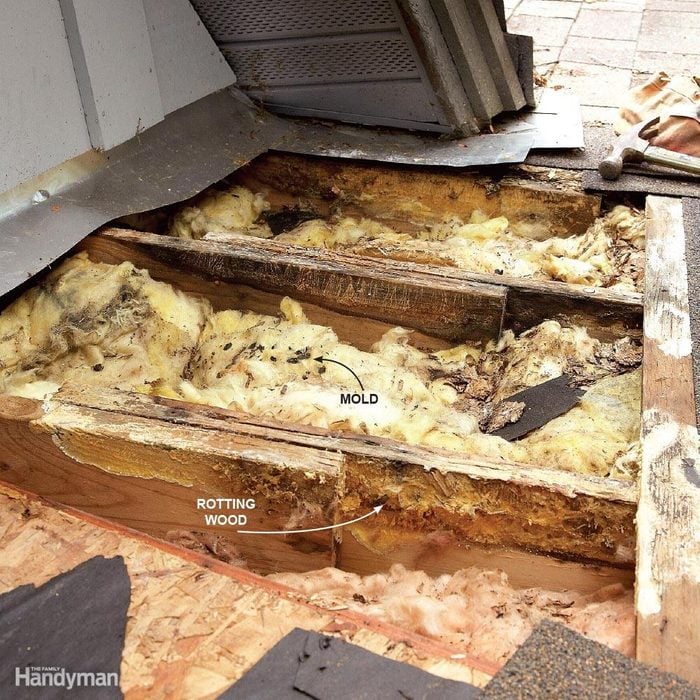
Leaky Roof Overview
If you have water stains that extend across ceilings or run down walls, the cause is probably a leaky roof. Tracking downwardly the leak is the hard part; the roof leak repair is usually pretty like shooting fish in a barrel. We'll bear witness you some uncomplicated tricks for finding and repairing most of the common types of leaky roofs. But if you live in the Snow Belt and in the winter you have leaks only on warm or sunny days, you probably accept water ice dams. We won't go into that roof leak repair in this story. Check out this commodity for more on preventing ice dams. If you have a leaky roof, you'd meliorate fix it immediately, even if information technology doesn't carp you much or you're getting a new roof next year. Even over a short time, pocket-size leaks tin can lead to big problems, such as mold, rotted framing and sheathing, destroyed insulation and damaged ceilings. The flashing leak that acquired an expensive repair bill was obvious from the ceiling stains for over two years. If the homeowner had dealt with it right abroad, the harm and subsequent repairs would take been minimal.
two / 12
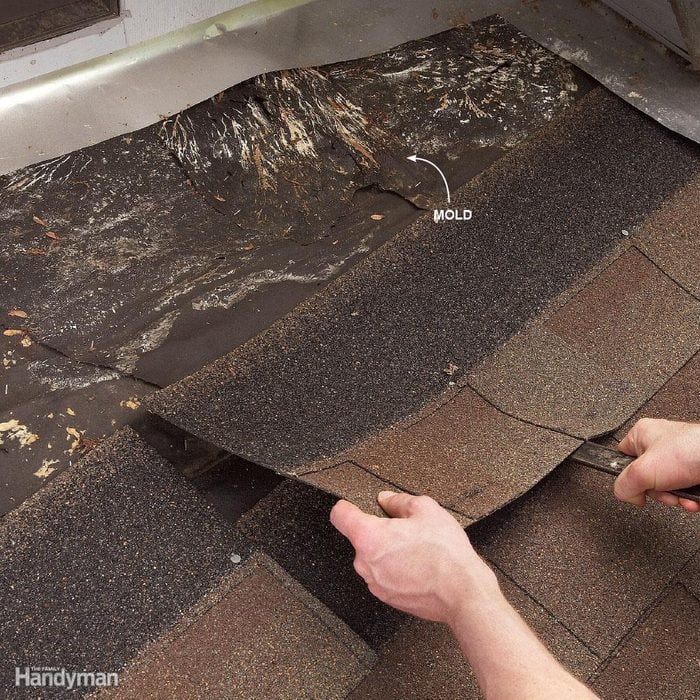
How to Observe Roof Leaks
When you lot're trying to track down a leak, outset by looking at the roof uphill from the stains. The outset thing to look for is any roof penetrations. Items that penetrate the roof are by far the near common source of leaks. In fact, information technology's rare for leaks to develop in open up areas of uninterrupted shingles, even on older roofs. Penetrations tin can include plumbing and roof vents, chimneys, dormers or annihilation else that projects through the roof. They can be several feet above the leak or to the correct or left of it. If you have attic admission, the easiest way to track downwardly a leak is to get up there with a flashlight and look for the evidence. There will be water stains, blackness marks or mold. But if access is a problem or yous have a vaulted ceiling, you'll take to get upwards onto the roof and examine the doubtable(s).
3 / 12
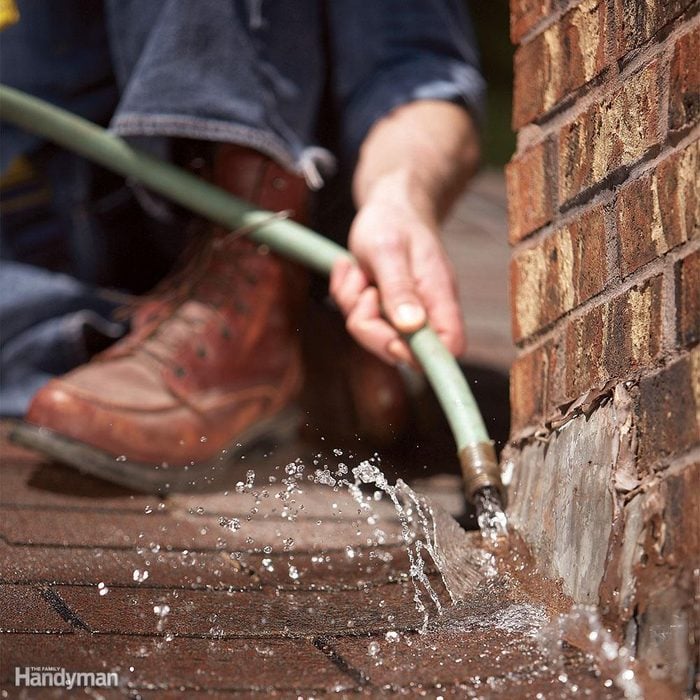
A Trick for Finding Difficult Leaks
If a leak is hard to observe, enlist a helper and go up on the roof with a garden hose. Outset depression, soaking the area just above where the leak appears in the business firm. Isolate areas when you run the hose. For example, soak the downhill side of a chimney first, then each side, then the top on both sides. Have your helper stay inside the house waiting for the baste to appear. Let the hose run for several minutes in one expanse earlier moving it upwards the roof a lilliputian farther. Tell your helper to yell when a baste becomes visible. You'll exist in the neighborhood of the leak. This process can take well over an 60 minutes, so be patient and don't move the hose too soon. Purchase your helper dinner. If running water doesn't reveal the exact location of the leak, don't be timid. Starting time removing shingles in the doubtable expanse. With them removed, at that place'll be testify of the leak and you'll be able to track it downwardly correct to the source. Y'all'll see discolored felt newspaper or water-stained or fifty-fifty rotted woods straight below and around a leaky roof.
4 / 12
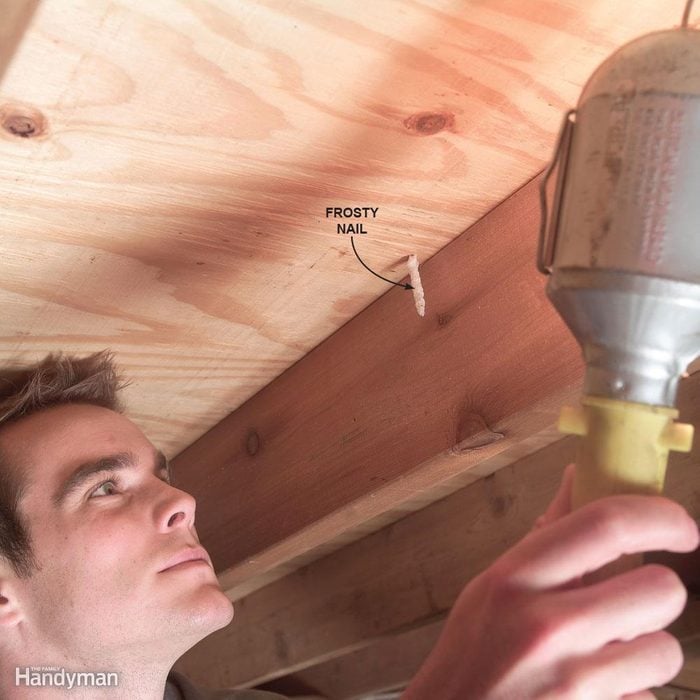
Solution for a Small Leak
Some roof leaks are tough to locate. Sometimes the water shows up at a ceiling spot distant from the leak. If your ceiling has a plastic vapor bulwark between the drywall and the attic insulation, push the insulation aside and look for menstruum stains on the plastic. Often water runs to openings in the vapor barrier, such as at ceiling light fixtures.
If you lot can't see any telltale period marks, and since the stain is fairly minor, look at the underside of the roof for 'shiners.' A shiner is a nail that missed the framing fellow member, in this example when the carpenter nailed the roof sheathing to the rafters. Wet that escapes into the cold cranium from the rooms below often condenses on cold nails. Sometimes you can spot this if you climb up into your attic on a common cold night. The nails will look white because they're frosted. When the attic heats up a bit during the twenty-four hours, the frost melts and drips, and so the nails frost up at night again and so on. The solution is to simply prune the smash with a side-cut pliers.
v / 12

Fix Plumbing Vent Boots
Plumbing vent boots tin can exist all plastic, plastic and metal, or fifty-fifty two-slice metal units. Cheque plastic bases for cracks and metallic bases for cleaved seams. And so examine the rubber kicking surrounding the pipage. That can be rotted away or torn, assuasive water to work its manner into the house along the pipe. With any of these problems, you should buy a new vent boot to supercede the onetime i. But if the nails at the base are missing or pulled free and the kicking is in skilful shape, replace them with the prophylactic-washered screws used for metal roofing systems. You'll find them at any abode eye with the rest of the screws. You'll have to work neighboring shingles complimentary on both sides. If you don't accept extra shingles, be conscientious when y'all remove shingles so they tin be reused. Employ a apartment bar to separate the sealant between the layers. And then you'll exist able to bulldoze the flat bar under the nail heads to pop out the nails.
half-dozen / 12
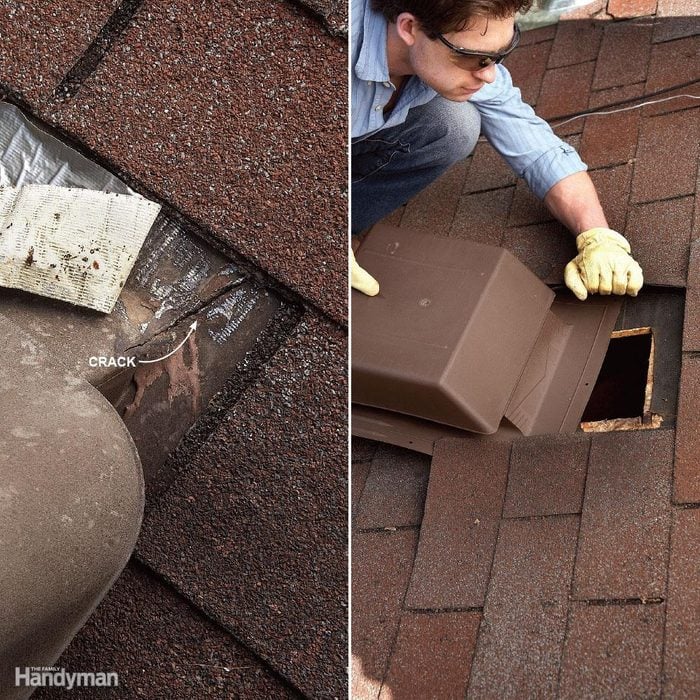
How to Fix Roof Vents
Check for cracked housings on plastic roof vents and broken seams on metallic ones. You might be tempted to throw caulk at the problem, simply that solution won't terminal long. There's really no fix other than replacing the damaged vents. Likewise look for pulled or missing nails at the base's lesser edge. Supplant them with prophylactic-washered screws. In most cases, you tin can remove nails under the shingles on both sides of the vent to pull it free. In that location will be nails across the top of the vent too. Normally you can also work those loose without removing shingles. Screw the bottom in identify with safe-washered screws. Clasp out a dewdrop of caulk beneath the shingles on both sides of the vent to hold the shingles down and to add a water barrier. That's much easier than renailing the shingles.
seven / 12

Fix Walls and Dormers
Water doesn't ever come in at the shingled surface. Oft, wind-driven rain comes in from above the roof, especially around windows, between corner boards and siding, and through cracks and knotholes in siding. Dormer walls provide lots of spots where water can dribble down and enter the roof. Caulk can be old, cracked or fifty-fifty missing between the corner boards and between window edges and siding. Water penetrates these cracks and works its manner behind the flashing and into the house. Fifty-fifty caulk that looks intact may not be sealing confronting the adjoining surfaces. Dig around with a putty knife to see if the area is sealed. Dig out any suspect caulk and replace it with a high-quality caulk. Also check the siding in a higher place the step flashing. Supercede whatsoever croaky, rotted or missing siding, making sure the new slice overlaps the step flashing past at least two in. If you still have a leak, pull the corner boards free and check the overlapping flashing at the corner. Oft, there'due south old, hardened caulk where the two pieces overlap at the inside corner.
viii / 12

Complex Roof Trouble
This roof leaks during the snowy part of winter and during storms in the summertime, certainly due to poor flashing. The soffit that meets the roof is i of the toughest areas to waterproof. In the photograph, you lot can still encounter signs of an ice dam. An ice dam occurs when snow melts and the water freezes when it hits the colder edges of your roof. Eventually, h2o pools behind the dam and works its way support under the shingles and under the soffit until information technology finds an opening through the roof. The solution begins with good flashing since this should finish leaks from rainfall and might stop the leaks from ice dams as well. Begin past removing the shingles downwardly to the wood sheathing and sideslip a strip of adhesive ice-and-water barrier (available where covering repair products are sold) nether the soffit/principal roof joint. Depending on how the roofs join, you may have to cut a slot to work it in far enough. It should overlap another piece of ice-and-water barrier laid below, all the way down to the roof edge. This should comprehend the most leak-decumbent areas. Then reshingle, sliding metal footstep flashing behind the fascia board (the trim behind the gutter). The valley flashing, laid over the joint where the two roofs run into, should overlap the step flashing at to the lowest degree 2 in. If leaks go along to occur from ice dams, consider installing roof border heating cables. (Discover them locally at hardware stores or habitation centers.) Improved attic insulation and ventilation are usually the best means to prevent ice dams, but they might non be effective in this complicated leaky roof state of affairs.
9 / 12
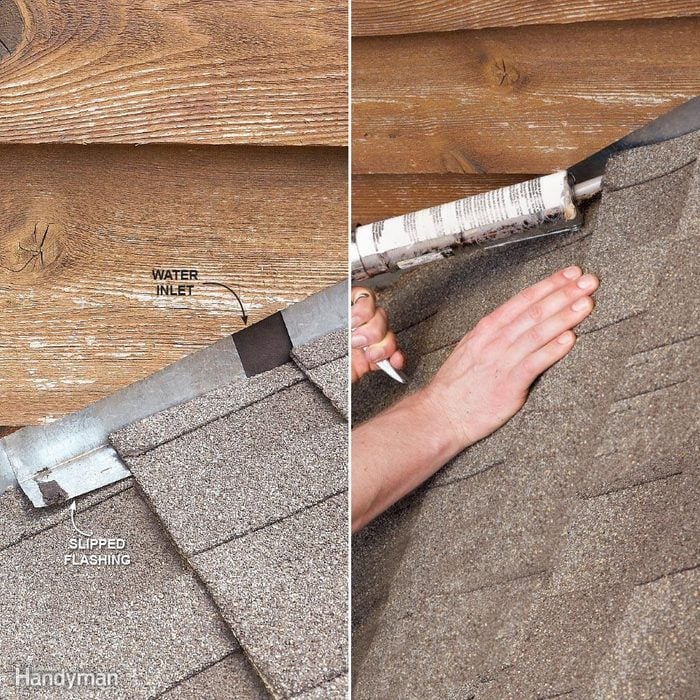
Set up Step Flashing
Step flashing is used along walls that intersect the roof. Each brusque section of flashing channels water over the shingle downhill from it. Only if the flashing rusts through, or a piece comes loose, h2o will run correct behind it, and into the house it goes. Rusted flashing needs to be replaced. That means removing shingles, prying siding loose, and and then removing and replacing the step flashing. It'south that simple. But occasionally a roofer forgets to nail one in place and information technology eventually slips downwardly to betrayal the wall. Cheque out this article for more on installing your ain pace flashing.
ten / 12

Don't Count on Caulk!
Rarely volition caulk or roof cement cure a leaky roof —at least for very long. You should e'er attempt a "mechanical" leaky roof set whenever possible. That means replacing or repairing existing flashing instead of using any type of sealant as a leak stopper. Merely use caulk for very small holes and when flashing isn't an option as a leak stopper.
11 / 12
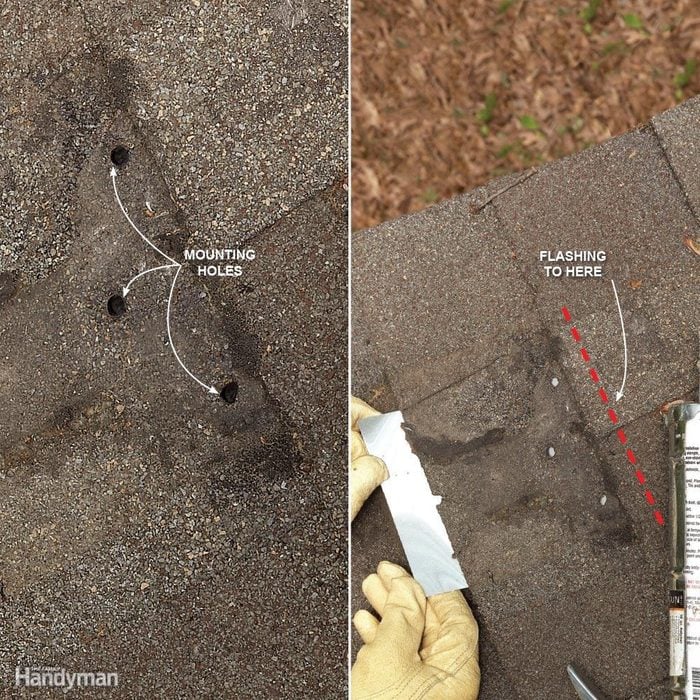
Fix Small Holes
Tiny holes in shingles are sneaky because they can cause rot, a leaky roof and other damage for years before you lot detect the obvious signs of a leak. You might find holes left over from a satellite dish or antenna mounting brackets or but about anything. And exposed, misplaced roofing repair nails should be pulled and the holes patched. Modest holes are simple to ready, but the set up isn't to inject caulk in the hole. You'll set up this leaky roof problem with flashing.
12 / 12

Leaks Around Brick Chimneys
All kinds of bad things can happen around brick chimneys. In fact, there are far too many to encompass in this story. Flashing around chimneys can rust through if it's galvanized steel, peculiarly at the 90-degree bend at the bottom. A quick only adequately long-term fix is to but sideslip new flashing under the old rusted stuff. That way any water that seeps through will be diverted. The all-time fix, though, is to cut a saw kerf into the mortar and install new flashing. Get complete instructions on how to install chimney flashing.
If yous're in search of a good ladder to go you lot upwards on the roof, check out this video from Stuff We Love on the Little Behemothic 22-foot ladder, which is available on Amazon.
Originally Published: July 18, 2022
Source: https://www.familyhandyman.com/list/roof-repair-how-to-find-and-fix-roof-leaks/

0 Response to "How To Repair Hole In Roof"
Post a Comment